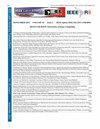Systematic Review of Radio Wave Techniques for Indoor Positioning Systems
IF 1.3
4区 工程技术
Q3 COMPUTER SCIENCE, INFORMATION SYSTEMS
引用次数: 0
Abstract
Indoor human positioning has become crucial for applications such as health monitoring, security surveillance, human pose identification and rescue operations. However, achieving reliable indoor human positioning is challenging due to numerous constraints.This paper aims to compare and analyze radio waves techniques and approaches for indoor positioning,providing a comprehensive review for human detection, positioning and activity recognition. A systematic review of the scientific literature and datasets was conducted. Four digital libraries, ACM Library Digital, IEEE Xplore, ScienceDirect and Spring Link were searched to identify results that met the selection criteria. A data extraction process was performed on the selected articles and datasets. The Parsifal platform was utilized to extract relevant information. After completing the systematic review, It was identified 26 eligible articles and extracted 11 methods for radio wave detection. The overview of indoor positioning system with radio waves was introduced. The most frequently mentioned tools in the articles for the capture stage were Radar Sensors, Wireless Sensor, and Antennas. For the processing stage, DNN Techniques, Processing Algorithms followed by Filtering, Fingerprint, Trilateration, and other machine learning algorithms formed the majority.室内定位系统无线电波技术综述
室内人体定位已成为健康监测、安全监视、人体姿势识别和救援行动等应用的关键。然而,由于诸多限制,实现可靠的室内人体定位是具有挑战性的。本文旨在比较和分析无线电波在室内定位中的技术和方法,为人体检测、定位和活动识别提供全面的综述。对科学文献和数据集进行了系统的回顾。四个数字图书馆,ACM数字图书馆,IEEE explore, ScienceDirect和Spring Link被搜索以确定符合选择标准的结果。对选定的文章和数据集进行数据提取处理。利用Parsifal平台提取相关信息。完成系统综述后,筛选出26篇符合条件的文章,提取出11种无线电波检测方法。介绍了无线电波室内定位系统的研究概况。文章中最常提到的捕获阶段的工具是雷达传感器、无线传感器和天线。在处理阶段,DNN技术、处理算法、滤波、指纹、Trilateration等机器学习算法占多数。
本文章由计算机程序翻译,如有差异,请以英文原文为准。
求助全文
约1分钟内获得全文
求助全文
来源期刊

IEEE Latin America Transactions
COMPUTER SCIENCE, INFORMATION SYSTEMS-ENGINEERING, ELECTRICAL & ELECTRONIC
CiteScore
3.50
自引率
7.70%
发文量
192
审稿时长
3-8 weeks
期刊介绍:
IEEE Latin America Transactions (IEEE LATAM) is an interdisciplinary journal focused on the dissemination of original and quality research papers / review articles in Spanish and Portuguese of emerging topics in three main areas: Computing, Electric Energy and Electronics. Some of the sub-areas of the journal are, but not limited to: Automatic control, communications, instrumentation, artificial intelligence, power and industrial electronics, fault diagnosis and detection, transportation electrification, internet of things, electrical machines, circuits and systems, biomedicine and biomedical / haptic applications, secure communications, robotics, sensors and actuators, computer networks, smart grids, among others.
 求助内容:
求助内容: 应助结果提醒方式:
应助结果提醒方式:


